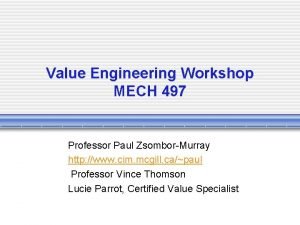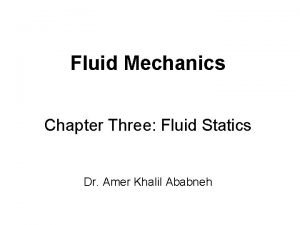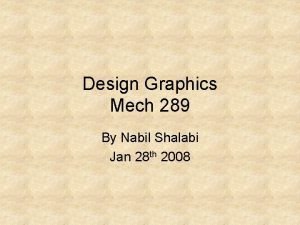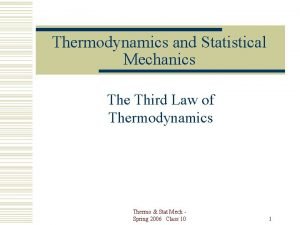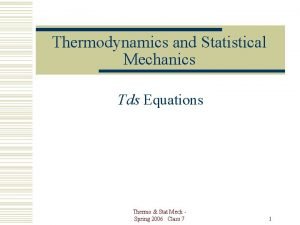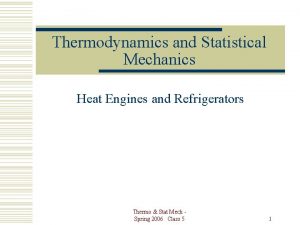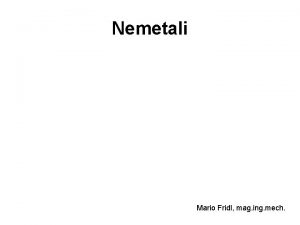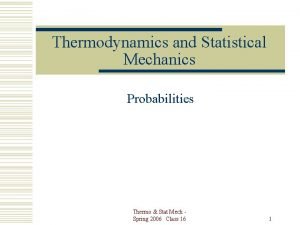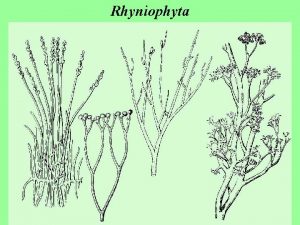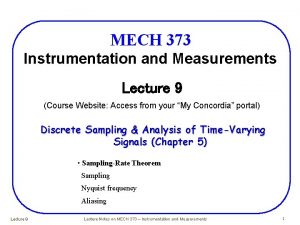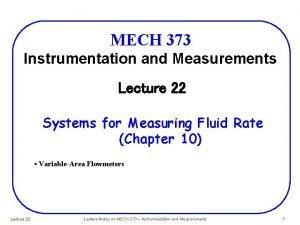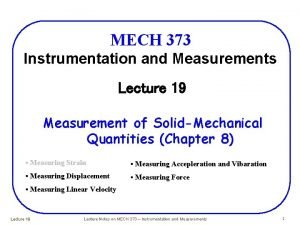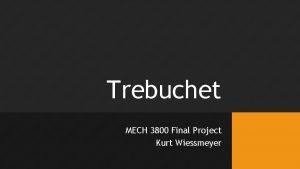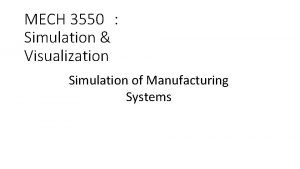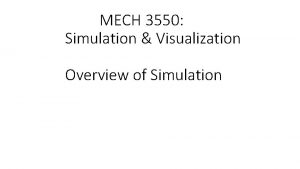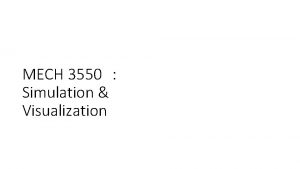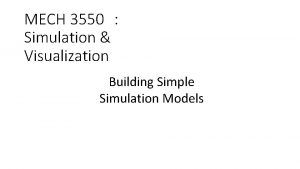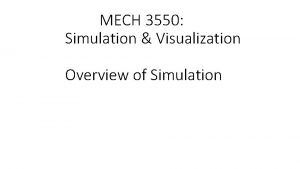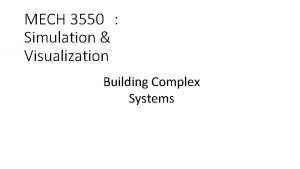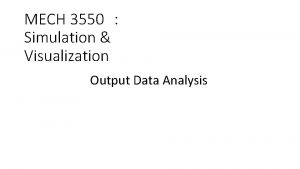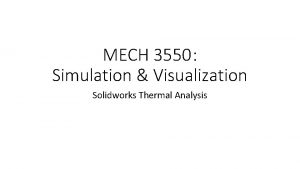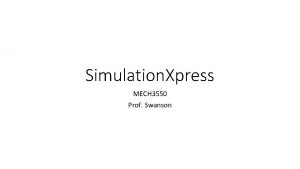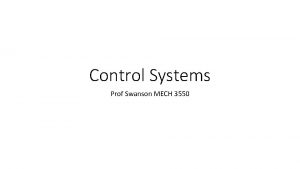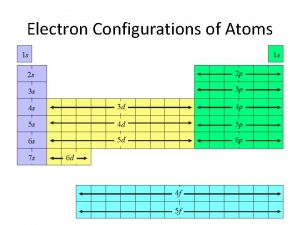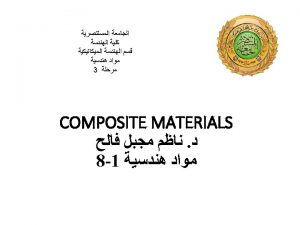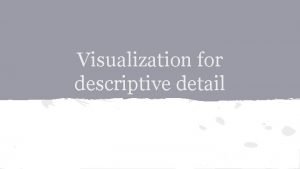MECH 3550 Simulation Visualization Comparing Alternative System Configurations



















- Slides: 19

MECH 3550 : Simulation & Visualization Comparing Alternative System Configurations

Ways to Compare Two systems: • A paired Confidence Interval • A Modified Two-Sample-t Confidence Interval • Comparisons based on Computer Simulation (Matlab) More than two systems: • Comparisons with a Standard • Pairwise Comparisons • Multiple Comparisons with the Best Model

Comparing Simulink Models • • • Navigate the Simulink Model Comparison Report Step Through Changes Explore Changes in the Original Models Merge Differences Open Child Comparison Reports for Selected Nodes Understand the Report Hierarchy and Matching Filter Out Differences Change Color Preferences Save Comparison Results

Navigate the Simulink Model Comparison Report • You can compare models from any version of Simulink®. • The comparison tool produces a comparison report based on the SLX files, resaved in the current version if necessary. • Use the report to explore the differences, view the changes highlighted in the original models, and merge differences.

Navigate the Simulink Model Comparison Report cont’d • Selected items that appear highlighted in a box. • If the selected item is part of a matched pair it is highlighted in a box in both left and right trees. • When you select an item, the original model displays and the corresponding item is highlighted.

Report item highlighting indicates the nature of each difference Type of report item Highlighting Notes Modified Purple Modified items are matched pairs that differ between the two files. When you select a modified item it is highlighted in a box in both trees. Changed parameters for the selected pair are displayed underneath. Inserted Blue Deleted Orange Container None When you select an unmatched item it is highlighted in a box in one tree only. Rows with no highlighting indicate a container item that contains other modified or unmatched items.

To Expand or filter the Tree View • Filter — Opens the Filter list. Select items to enable or disable display of categories of changes in the report. Use the filters to show only the changes you are interested in. By default the report hides all nonfunctional changes, such as repositioning of items. Turn off filters to explore all differences including nonfunctional changes. See Filter Out Differences. • Find — Opens the Find dialog box where you can search for items. • If you want to swap the files, on the Comparison tab, select Swap Sides. The report swaps the sides and reruns the comparison. Refresh also runs the analysis again.

Step Through Changes • On the Comparison tab, in the Navigate section, when you click the Next arrow button (or press the Down key when the report has focus), you step through groups of changes in the report, in the following order: • The first time you click Next, it selects the first changed (purple) or inserted (blue) node. • Step through the differences with the Next button. • When selected items have a match in the right tree then they are also highlighted. • Next skips white nodes with no color background, if they have no parameter changes underneath. White nodes are parts of the hierarchy that contain no differences.

Step Through Changes Cont’d • If there is an insertion or deletion with child nodes, Next skips the child nodes if they are all also insertions or deletions. For example, if you insert a subsystem, Next selects the top subsystem node, then skips all the nodes inside the subsystem (if they are all also insertions) and selects the next difference. • Next minimizes context switching when highlighting in models. When you click Next, the report steps through all differences at the same level of the model, subsystem, or chart, in both left and right trees in the report, before moving to the next level of the report. For example, you step through all differences in a subsystem in the left and right trees, before moving to another subsystem. • When you have stepped through all changes, Next stops at the end. • If you click an item in the report, the Next/Previous controls will step through changes from the point you selected.

Explore Changes in Original Model • When you compare Simulink models, you can choose to display the corresponding items in the original models when you select report items. • You can use this highlighting function to explore the changes in the original models. When you select an item, the report highlights the corresponding item in the model. • Control the display by using the Highlight Now button and the Always Highlight in Models check box.

Merge Differences • To merge, on the Comparison tab, click Merge. The Target pane appears at the bottom of the report. • Use the buttons to select differences to keep in the target.

Open Child Comparison Reports • If additional comparisons are available for particular parameters, you see a Compare button to open a report for that pair of nodes • For example, if there are differences in the Model Workspace, you can click Compare to open a new report to explore differences in variables.

Open Child Comparison Reports cont’d • You can open a new comparison for parameters when the report cannot display all the details. • If the original models contain MATLAB Function block components, and if differences are found, click the COMPARE button at the end of the MATLAB Function block report items to open new comparisons in the Comparison Tool, showing the text differences in MATLAB Function block code from the text comparison report. • If the original models contain truth tables, and if the differences are found: • Click the COMPARE button at the end of the MATLAB Function node to see a summary of all changes • Click the truthtable node to reverse annotate and display both truthtable editors.

Open Child Comparison Reports cont’d • If the original models contain truth tables, and if the differences are found. • Click the COMPARE button at the end of the MATLAB Function node to see a summary of changes • Click the truthtable node to reverse annotate and display both truthtable editors • Click the COMPARE button on the parameter to open a new text comparison showing only Condition table differences • Similarly click the COMPARE button for Action Table to view only Action changes

Filter Out Differences • You can use the Filter button on the View tab to control display of categories of changes. Turn off filtering to view all identified changes. • In the Filter list, select check boxes to enable or disable display of categories of changes in the report. • Use the filters to show only the changes you are interested in. • Turn off filters to explore all differences including nonfunctional changes. • Try this if you cannot see changes you expected to see in the report.

Categories for Filtering Out Differences • Hide Changes in Lines. Hide all changes to signal lines including functional changes. • Hide Nonfunctional Changes. The report processing identifies certain items in the model file as nonfunctional, for example, items representing parameters such as block, system, chart or label positions, font and color settings for blocks and lines, and system print and display settings • Hide Changes in Block Parameter Defaults. Hiding changes in defaults can avoid duplication in the report, as any changes in blocks are also reported as functional changes where you can use highlighting. Block parameter defaults are an undocumented part of the Simulink model file that store the default parameters for the blocks used in a model

Exceptions • The report does NOT filter out changes to Block and System names, annotations, and Stateflow Notes as nonfunctional. • The report always displays these changes to facilitate review of code changes, because they can contain important information about users' intentions. • In certain rare cases the report filters out changes that can impact the behavior of the design • By default moves are filtered as nonfunctional, but in the following cases moves can change design behavior: • Moving blocks can in some cases change the execution order. • In a Stateflow chart, if you move states or junctions so that they intersect, the model fails to simulate.

Change Color Preferences 1. On the Matlab Home tab, click Preferences 2. In the Preferences dialog box, under MATLAB, click Comparison. 3. Edit color settings as desired for differences and merges. View the colors in the Sample pane. 4. To use your modified settings in the comparison, click Apply and refresh the comparison report. 5. To return to the default color settings, in the Preferences dialog box, click Reset and click Apply. Refresh the comparison report. 6. If you want to save your modified color preferences for use in future MATLAB sessions, click Save As. Enter a name for your color settings profile and click OK. 7. After saving settings, you can select them in the Active Settings list.

Save Comparison Results • To save your comparison results, use these Comparison tab buttons: • Publish > HTML or Word — Open the Save dialog box, where you can choose to save a printable version of the comparison report. See Save Printable HTML Report. • Publish > Workspace Variable — Export comparison results to workspace. See Export Results to the Workspace. • https: //www. mathworks. com/help/simulink/ug/compare-simulationdata. html#bu 0 siq 9



